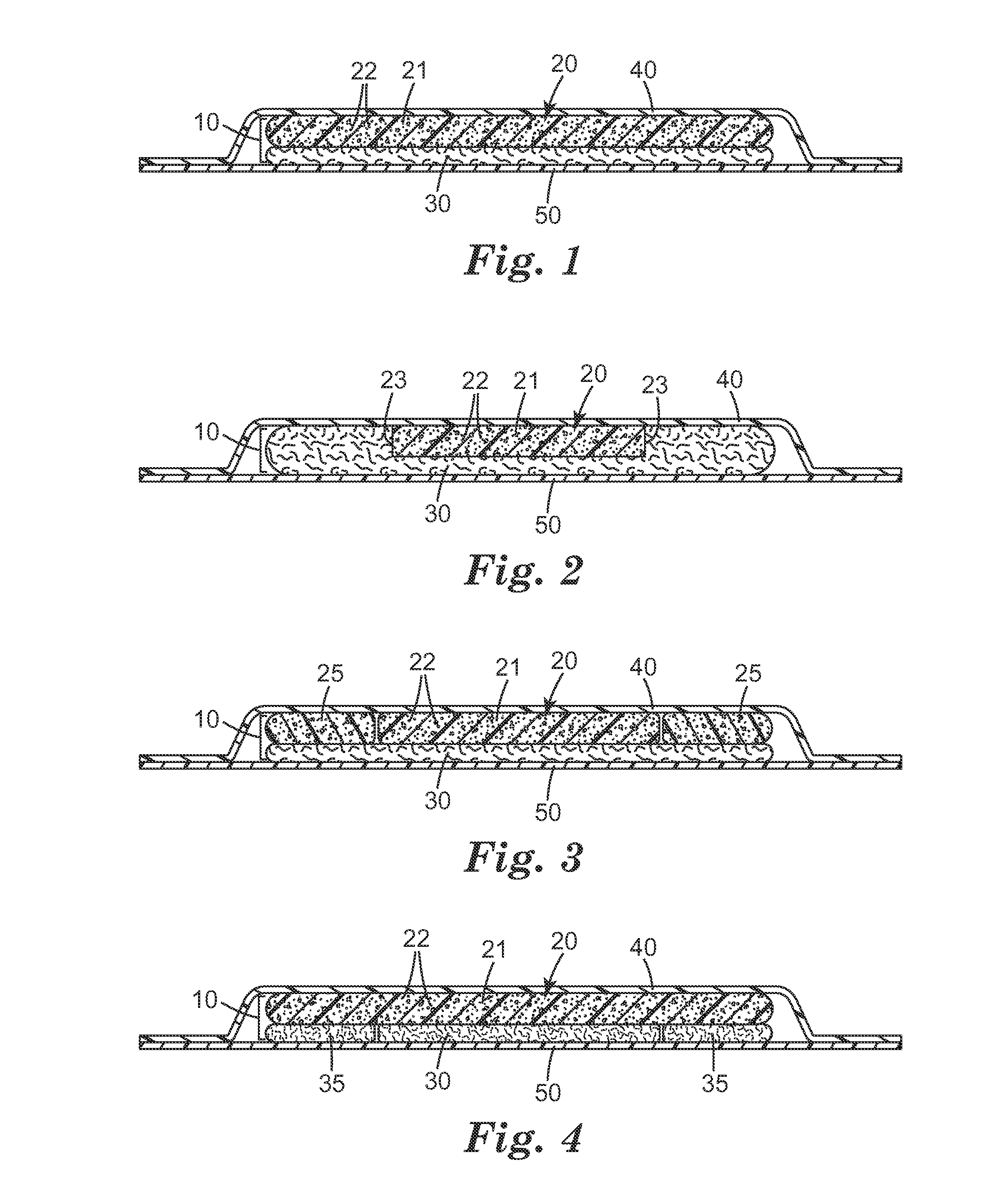Absorbent article comprising polymeric foam with superabsorbent and intermediates
a technology of absorbent articles and foam, applied in the direction of bandages, chemistry apparatus and processes, other chemical processes, etc., can solve the problem that materials have also been described as not enhancing fluid transpor
- Summary
- Abstract
- Description
- Claims
- Application Information
AI Technical Summary
Benefits of technology
Problems solved by technology
Method used
Image
Examples
composite example 1
Absorbent Composite Example 1
[0108]The open cell polyurethane foam layer was prepared by adding the polymeric MDI RUBINATE 1245 (54.5 parts, 26.14 wt-% of the polyurethane) to a mixture of CDB-33142 (100 parts, 47.97 wt-%), superabsorbent polymer LIQUIBLOCK HS Fines (40 parts, 19.19 wt-%), CARBOPOL GP-700 (2.4 parts, 1.15 wt-%), water (1.2 parts, 0.58 wt-%), triethanolamine LFG (3.7 parts, 1.77 wt-%), DABCO DC-198 (2.0 parts, 0.96 wt-%), ARCOL E-434 (4.0 parts, 1.92 wt-%), DABCO 33-LV (0.45 parts, 0.22 wt-%), DABCO BA-100 (0.12 parts, 0.06 wt-%), and DABCO BL-17 (0.10 parts, 0.05 wt-%). All the components were at room temp (70° F.) with the exception that CDB-33142 was at 40° F. The polyol components were premixed for about 15 seconds and then mixed with the MDI for an additional 10-12 seconds. The mixture was immediately poured onto polypropylene coated release paper (14 mils thick). A second sheet of polypropylene coated release paper contacted the opposing surface of the foam as ...
composite example 2
Absorbent Composite Example 2
[0110]The open cell polyurethane foam layer was prepared using the same conditions as described in Example 1 with the exception that 30 parts, instead of 40 parts, of the superabsorbent polymer LIQUIBLOCK HS FINES was used. After casting and oven curing at 100° C. for 5 minutes, the resulting polyurethane open cell foam was measured to be on average 3.0 mm thick, with an average density of 0.084 g / cc (5.21 lbs / ft3). The average basis weight of the foam was 253 gsm.
[0111]The foam layer was adhesively laminated to Gelok 5040-72 using Spray 77 adhesive. The bi-layer construction was on average 3.3 mm thick, and had an average basis weight of 381 gsm. The absorption capacity was 13.41 g / g (1.55 g / cc); the strike through time was 2.0 seconds; and the rewet was 0.23 grams.
composite example 3
Absorbent Composite Example 3
[0112]The open cell polyurethane foam layer was prepared using the same conditions as described in Example 1 with the exception that 20 parts, instead of 40 parts, of the superabsorbent polymer LIQUIBLOCK HS FINES was used. After casting and oven curing at 100 ° C. for 5 minutes, the resulting polyurethane open cell cast foam was measured to be on average 3.0 mm thick, with an average density of 0.084 g / cc (5.21 lbs / ft3). The average basis weight of the foam was 251 gsm.
[0113]The foam layer was adhesively laminated to Gelok 5040-72 using Spray 77 adhesive. The bi-layer construction was on average 3.3 mm thick, and had an average basis weight of 392 gsm. The absorption capacity was 12.58 g / g (1.49 g / cc); the strike through time was 3.3 seconds; and the rewet was 0.13 grams.
PUM
| Property | Measurement | Unit |
|---|---|---|
| Fraction | aaaaa | aaaaa |
| Force | aaaaa | aaaaa |
| Size | aaaaa | aaaaa |
Abstract
Description
Claims
Application Information
 Login to View More
Login to View More - R&D
- Intellectual Property
- Life Sciences
- Materials
- Tech Scout
- Unparalleled Data Quality
- Higher Quality Content
- 60% Fewer Hallucinations
Browse by: Latest US Patents, China's latest patents, Technical Efficacy Thesaurus, Application Domain, Technology Topic, Popular Technical Reports.
© 2025 PatSnap. All rights reserved.Legal|Privacy policy|Modern Slavery Act Transparency Statement|Sitemap|About US| Contact US: help@patsnap.com


